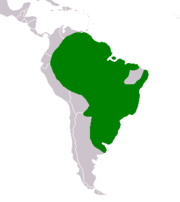Hydrochoerus
| Hydrochoerus | |
|---|---|

| |
| H. hydrochaeris with a cattle tyrant on its back | |
| Scientific classification | |
| Domain: | Eukaryota |
| Kingdom: | Animalia |
| Phylum: | Chordata |
| Class: | Mammalia |
| Order: | Rodentia |
| Family: | Caviidae |
| Subfamily: | Hydrochoerinae |
| Genus: | Hydrochoerus Brisson, 1762 |
| Type species | |
| Species | |
|
H. hydrochaeris H. isthmius
| |

| |
| Ranges of capybara (green) and lesser capybara (red) | |
The genus Hydrochoerus contains two living and three extinct species of rodents from
Characteristics
Capybaras are
Behavior
Capybaras are highly social, living in groups of up to 100 and communicating through a variety of vocalizations.[2] Breeding is polygynous, with males forming harems.
Phylogeny and taxonomy
The extinct North American species formerly recognized as
Species
Extant Species
| Common name | Scientific name and subspecies | Range | Size and ecology | IUCN status and estimated population |
|---|---|---|---|---|
| Capybara | Hydrochoerus hydrochaeris , 1766)
(Linnaeus |
South America
|
Size: Habitat: Diet: |
LC
|
| Lesser capybara | Hydrochoerus isthmius , 1912
Goldman |
eastern Panama, northwestern Colombia, and western Venezuela.
|
Size: Habitat: Diet: |
DD
|
Fossils
- † Hydrochoerus gaylordi – Plio-Pleistocene capybara endemic to the Caribbean island of Grenada[6][7]
- † Hydrochoerus hesperotiganites – Late Pleistocene capybara endemic to North America (San Diego County, California)[8]
Distribution
Presently, capybaras live in northern South America and adjacent southern Central America (lesser capybara) and in the tropical to subtropical regions of South America (capybara). The fossil species inhabited Buenos Aires Province in Argentina (H. ballesterensis) and the Caribbean island of Grenada (H. gaylordi). One species, H. hesperotiganites even ranged as far north as California.[8] Fossils of unspecified Hydrochoerus have been found in Late Pleistocene to Holocene sediments of Curití, Santander, at an altitude of 1,500 m (4,900 ft) in the Eastern Ranges of the Colombian Andes. Fauna found at the same site included the South American tapir (Tapirus terrestris), Cryptotis sp., collared peccary (Tayassu tajacu), white-lipped peccary (Tayassu pecari), and Mazama sp.[9][10]
References
- ^ OCLC 62265494.
- ^ a b Rowe and Honeycutt, 2002
- PMID 16085429.
- ^ "Neochoerus aesopi Leidy 1853 (caviomorph)". Fossilworks. Retrieved 2016-05-16.
- ^ Hydrochoerus ballesterensis at Fossilworks.org
- S2CID 53542296.
- ^ Hydrochoerus gaylordi at Fossilworks.org
- ^ S2CID 247352090.
- ^ Curití, Santander at Fossilworks.org
- ^ Hoffstetter, 1971, p.54
Bibliography
- Hoffstetter, Robert (1971). "Los vertebrados cenozóicos de Colombia: yacimientos, faunas, problemas planteados" (PDF). Universidad Nacional de Colombia: 37–62. Archived from the original (PDF) on 2017-04-06. Retrieved 2017-04-05.
{{cite journal}}: Cite journal requires|journal=(help) - Rowe, D.L.; Honeycutt, R.L. (2002). "Phylogenetic relationships, ecological correlates, and molecular evolution within the Cavioidea (Mammalia, Rodentia)". PMID 11861886.
Further reading
- Nowak, Ronald M. (1999). Walker's Mammals of the World, 6th edition. Johns Hopkins University Press. pp. 1–1936. ISBN 978-0-8018-5789-8.


